Hellenic Alliances
From Working to Preserve Our Heritage: The Incredible Legacy of Greek-American Community Services
"Since its earliest days, Greek-American Community Services cooperated with many organizations within Chicago’s Greek community. Some of these relationships grew into steadfast alliances while others, regardless of efforts made on our part, never came to fruition, or if they did, were minimal in impact.
The closest relationship GACS had by far was with the Greek-American Nursing Home Committee. GACS had been the parent organization, and after separating, we continued as sister organizations. Many of the board members served on both boards. There was an effort by a few on the nursing home committee, particularly Helen Georges, to distance the committee from GACS. Although this created some tension early on, the ties between the two organizations were strong and remained so throughout the existence of GACS.
Beyond founding the Greek-American Nursing Home Committee and nurturing it through its first few years of operation, GACS and the GANHC worked together in many ways. GACS board members that were also on the board of the nursing home committee included: Emily Alexandrou, Helen Geocaris, Thalia Jameson, Bill Kakavas, Mary Kakavas, Jean Kaporis, Dr. Theodosis Kioutas, Anna Manos, Toni Panos, Dr. Nicholas Papanos, John Psiharis, John Rassogianis, and Elaine Thomopoulos. Elaine served as second vice president of the GANHC for many of these years and I was assistant treasurer for a period. GACS was the regular meeting place for most nursing home board and committee meetings.
Ethel Kotsovos, GACS social worker, at first volunteered and later was paid, to run the Greek-American Nursing Home Committee office located within Dr. Kioutas’ medical suite on California Avenue near Lincoln Avenue. Before her staff role, Ethel was a GANHC board member.
John Rassogianis, a GACS board member, and then Cultural & Arts Program director, was a board member of the nursing home committee and its publicity chairman. In that capacity, he generated many press releases and other publicity activities to help inform and update the Greek community. John also represented the GANHC on the board of the Coalition of Limited English Speaking Elderly (CLESE).
Maria Toledo (Villalobos) eventually became the secretary/administrative assistant for both organizations, dividing her time between the GACS and GANHC offices.
The GACS Ya’Sou vans were used on several occasions to transport residents from Hollywood House to GANHC fundraisers and to shuttle riders between the GACS center and GANHC events in Wheeling.
A 1994 study conducted by GACS for the GANHC Certificate of Need, coordinated by Ethel, found that there were 340 Greek elderly nursing home residents scattered throughout 85 facilities and that another 400 were expected to need adult day care or nursing home care within the next three years. The results of the survey were also used by the GANHC to document the need for a nursing home in fundraising, publicity, and obtaining zoning. The study further detailed data gleaned from the 1990 census by Northeastern Illinois University. There were approximately 240,000 Greek Americans in the Chicago metropolitan area. It found that 21 percent or 50,400 were over age 60 and 23 percent, or 11,592 were non-English speaking.
One of these individuals was Efthimios Vlahos. Mr. Vlahos was an adult day care client for several years. In his 90s, Efthimios was alert but physically frail and actively participated in center programming. A favorite activity for him was to teach Greek to Ricardo Rodriguez, a non-Greek volunteer who eventually became a GACS board member. Efthimios prepared weekly lessons and engaged in conversational Greek with Ricky. He also joined in with fabric arts participants during their Wednesday classes. Efthimios was an ardent supporter of the nursing home project and had hoped to be the first resident of the new facility. He frequently inquired about the latest progress and any news on the project. Efthimios and his family attended several GANHC fundraisers, and he was profiled in the Groundbreaker, the GANHC newsletter. For some of us, Efthimios epitomized the need for a nursing home. He was the face for the home we were working to establish. Unfortunately, his health declined, and he was admitted into an area nursing home. He died in February 2002 at the age of 95, just weeks before GANHC admitted its first residents in early March. GACS and GANHC members, and several of his friends from the center, visited him at the nursing home and attended his wake.
A profile of Efthimios in the Fall 2001 issue of the Greek-American Nursing Home Committee Newsletter, read in part:
Efthimios Vlahos is 95 years old and has anxiously been waiting for the Greek American Rehabilitation and Nursing Centre to open. He would like to be the first resident.
Mr. Vlahos is very social, loves the companionship of friends, and looks forward to having a conversation with anyone around him who is pleasant, but he cannot. He would like to have a Greek meal regularly, but he cannot. Mr. Vlahos has been in a very fine nursing care facility for several years. All his physical needs are met. He longs for “parea” (companionship). His English is limited, and he has no one to speak with in his native tongue most of the time. He can’t wait to be transferred to our nursing home.
After the death of his wife Maria, Mr. Vlahos followed his sons, George, Elias, and Constantine to America in 1969. He had passed some very hard times in his village of Kalavrita. First the Italians, then the Germans, and lastly the “Antartes” (the leftists in the civil war). His homes were burned twice because he was anti-Communist. He served as a soldier twice. Mr. Vlahos and his sons are donors and their Society Kalavriton made a generous donation to the nursing home project. Now, all he wants is to be in a dignified, orthodox, and Hellenic environment. He is on our waiting list.
Another example of the need for the nursing home project was Mrs. Stella C. Coroneos. Profiled as “Someone You Should Know,” in the Spring 2000 issue of the Greek-American Nursing Home Committee Newsletter:
Mrs. Coroneos has been a resident at Alshore Nursing Home in Chicago for seven years. She is 98 years old. Her life involved many changes and family tragedies.
She was born in Smyrna, Turkey, however, she and her family were forced to escape to Greece. She married in Greece and came to the United States with her husband in the 1930s. They had one son who passed away while at university when he was only 21 years old. She has been a widow for over 30 years.
Mrs. Coroneos began working after she lost her husband. While in Greece, she was one of the recipients of training in needlework at the “Vasiliki Pronia” (Queen’s Charity). She was very talented and was able to support herself and save some of her earnings.
In 1993 she fell and broke her hip. She became unable to care for her daily needs, and her doctor recommended she be placed in a nursing home. She states that she misses the friendships that she had, someone to speak with in Greek, and especially to worship in her church and celebrate religious holidays. When the plan to build a nursing care facility to meet the needs of Greek-Americans became known to her, tears came to her eyes, and she said, ‘I am sure to find friends there.’
Mrs. Coroneas is visited by a distant relative of her late husband. She has no one else.
GACS established and maintained good relationships with the community’s cultural organizations. We often co-sponsored various cultural programs that were originated by one of the other organizations. Co-sponsoring an event usually meant promoting and helping to organize the event as well as sharing proportionally in the expenses. Together, this arrangement helped to bring about an array of high-quality cultural and arts programs that the community would normally not have access to. These organizations included: The Greek Women’s University Club (GWUC), Hellenic Cultural Organization (HCO), Hellenic Professional Society of Illinois (HPSI), and KRIKOS.
We discussed establishing a clearinghouse/hotline for events in Chicago’s Greek community to avoid or at least minimize schedule conflicts. GACS coordinated this through funding from our annual CDBG grant. Organizations were asked to call or fax their event details to John before scheduling major activities to minimize schedule conflicts. Although successful to some extent, there was no consistent buy-in or participation by all, which continued to result in more than one event being scheduled on a particular day. At some point, we discontinued this service.
GACS maintained good relationships with many Greek fraternal organizations including the Cretan Federation, Pan Arcadian Federation, Pan Laconian Federation, Pan Macedonian Federation, Pan Messinian Federation, and the Hellenic Ladies Society of Constantinople. Dr. Kioutas, John, and I served as board members for the Chicago Council for Justice in Cyprus, which often held its meetings at GACS. In the early years, GACS and the Pan Laconian Federation co-sponsored holiday food drives for needy families. Pol Gavaris was active in the Federation and spearheaded this drive.
Relations with the Church could best be described as lukewarm. Although some parishes were supportive, Bishop Iakovos, who was later designated Metropolitan of Krinis, was not particularly supportive of GACS, and at this point was ambivalent about the GANHC. He only wholeheartedly embraced the nursing home project after the property was purchased and it became apparent that we would succeed with or without his involvement.
The Very Rev. Nikitas Lulias, chancellor of the Greek Orthodox Diocese of Chicago during the early years of GACS, was supportive of both organizations. He served on the Cultural & Arts Program Advisory Committee and coordinated a statewide dance program. Father Nikitas also attended our events and dinners and officiated the Agiasmos ceremonies during our open houses.
In my view, the powers that be within the community, or at least those who perceived themselves as leaders within the community, were against GACS because they saw it as competition with the Hellenic Foundation. The bishop, who was honorary chairman of the Hellenic Foundation, seemed to embrace these views. Although some churches supported GACS efforts at the parish level, no tangible support was received from either the archdiocese in New York or the Diocese of Chicago. The Diocesan Philoptochos Society did donate to GACS periodically. Individual churches and Philoptochos societies that supported us were usually inspired by members within the parishes who supported GACS and/or the nursing home committee. They included Annunciation Cathedral, Assumption, Holy Trinity, St. Andrew, St. Basil, St. Demetrios, and St. George.
By far, the most complicated relationship GACS navigated was with the Hellenic Foundation. Many of us believed that Cynthia Yannias, their executive director, unnecessarily created an “us versus them” mentality and seemed threatened in some way by GACS. Instead of embracing opportunities to work together, I was told by several who were involved with the Hellenic Foundation that Cynthia fostered an environment where GACS was a competitor and not a potential partner. They mentioned that she felt there should be one community organization - the Hellenic Foundation.
GACS believed the organizations should co-exist and that the community was better off because there was more than one organization focused on aiding and supporting the community. It made no sense for GACS to duplicate programs that were already being offered by the Hellenic Foundation, and it would be best to develop a seamless service system within the Greek community where clients were referred between organizations based on their needs. In short, we were not competitors, but unfortunately, opportunities to collaborate for the common good of our community were not possible in this environment. This was frustrating to many of us because there were areas that we could have worked on together for the benefit of the community that were never explored.
Soon after the ADC opened, Elaine, Ethel, and I met with Electra Tarsinos, who briefly served as the Hellenic Foundation’s director of social services. Electra was essentially a go-between for Cynthia and Angelike Mountanis, who was the director of the Foundation’s Hellenic Family and Community Services program. On a part-time basis, Electra commuted from her home in Princeton, Illinois to work in the city. Electra was also good friends with Ethel Kotsovos; they had gone to college together. We discussed how our two organizations could work together; however, little came of this since there was no desire to cooperate on their part.
At this time, many of the Greek “establishment” in Chicago were not supportive of GACS or the GANHC, although some became supportive as time went on. This was apparent in our dealings with the United Hellenic American Congress (UHAC), which claimed to be an umbrella organization for the Greek community. Founded and led by Andrew Athens, UHAC distinguished itself in lobbying for issues impacting Greece, Cyprus, and/or the Greek-American diaspora. UHAC supported the Hellenic Museum and Cultural Center, and the Hellenic Foundation, and helped launch International Orthodox Christian Charities (IOCC), of which Andrew Athens was a founding member. After UHAC purchased the Greek Star, the newspaper also functioned as their house organ, highlighting UHAC activities and priorities.
After a period of minimal communication with UHAC and the Hellenic Foundation, Andrew Athens, with little notice, invited the leadership of both GACS and GANHC to meet with the UHAC executive committee members in a hastily arranged meeting held on July 3, 1992, at the UHAC office on Michigan Avenue. GACS was represented by Evangeline, Elaine, and me. The GANHC was represented by Dr. Kioutas and Helen Georges. Dr. Kioutas, Elaine, and I wore two hats during this meeting representing both GACS and the GANHC. In addition to Andrew Athens, UHAC participants included Bill Vranas, Frank Kamberos, and Helen Alexander, executive secretary of UHAC. George Collias, board president, and Cynthia Yannias represented the Hellenic Foundation. His Grace Bishop Iakovos was also in attendance.
Once pleasantries were exchanged, Evangeline, Elaine, and I spoke about GACS while Dr. Kioutas and Helen discussed the nursing home. Cynthia and George then spoke on behalf of the Hellenic Foundation. They felt that the nursing home project should not move forward and argued there was little need for a Greek American nursing home and that it wouldn’t be financially viable. They felt that Hollywood House was sufficient for the community. In terms of GACS, Cynthia felt that GACS was taking money away from the Hellenic Foundation since they were also seeking community support. She felt there was a finite amount of money within the Greek community and that GACS and GANHC support was in effect reducing the amount of the pie available to them. The bishop was not enthusiastic about GACS and suggested that the GANHC consider a wing in a nursing home instead. He felt that a project of this magnitude would take years to achieve, if ever.
We in turn expressed our view that GACS attracted new dollars and grants to the community in support of services and programs that did not currently exist. Our community was enriched by these services. We did not see this as a competitive environment but one that should encourage cooperation and collaboration. Evangeline articulated what was referred to within GACS as the “Mistaras Doctrine.” This vision of Chicago’s Greek community included a troika of services to the elderly. The Hellenic Foundation would provide housing for independent seniors and homemaker services; GACS would offer mid-range services to the elderly through the adult day care center and the GANHC would offer intermediate and skilled nursing care as well as rehabilitation assistance. She viewed these three co-existing organizations to be the community’s safety net for its elders.
The result was that no meaningful UHAC or Hellenic Foundation support or cooperation was forthcoming for GACS or GANHC as a result of this meeting. Worth noting is that we did not acquiesce. We conveyed that our organizations would go on with or without the support of UHAC, the Hellenic Foundation, or the church. The tone of the meeting reflected the fragmented state of Chicago’s Greek community and a lack of unity, even though UHAC boasted that its role was to serve as an umbrella organization.
We were surprised but not surprised about the outcome of the meeting. Over coffee at a nearby downtown diner after the meeting, we discussed what had just happened. The overall feeling was that the individual churches would be supportive of the nursing home and that the bishop would come along eventually since he would not publicly want to be seen as an obstruction when the churches under his jurisdiction were supportive. The bishop’s focus was creating a Diocesan Retreat Center near Kenosha, Wisconsin. He was raising money for this and had requested the churches within the Diocese to support this effort. With or without the support of UHAC and the Hellenic Foundation, we resolved to move forward.
In 1993, Dr. Michael Bakalis briefly served as executive director of UHAC. That period was refreshing but short-lived. He formed a social services committee to encourage dialogue and cooperation related to social services. Mike hosted a couple of meetings with GACS and the Hellenic Foundation at UHAC’s office. I recall that Cynthia and I attended these meetings and perhaps others did as well. I do not remember much about what was discussed or the outcomes of these meetings, but the fact that we were talking was positive.
At the time, the annual Greek parade was organized by UHAC, and our request to waive the entry fee to have our Ya’Sou vans in the parade was turned down. As I recall, the fee was significant, and GACS board member Kostas Zografopoulos, the owner of Master Caterers, arranged with the parade coordinators for GACS to pass out water and cookies to parade marchers from the back of the Ya’Sou vans. Kosta provided the cookies, water jugs, and drinking cups. By doing so, the entry fee was waived, and the vans were able to take part in the procession. Passing out water and cookies made the GACS table a popular stop for parade marchers, and there were many visitors. Adult day care clients and volunteers were invited to ride in the vans along with the GACS board and staff.
A reflection of the solid relationships GACS had with fellow Greek cultural organizations was our participation in discussions with several organizations about the feasibility of establishing a Hellenic cultural center. John and I were invited to join the committee considering this possibility. The idea was to create a central gathering place where organizations could host meetings and events. Classrooms and a community library were part of the plan. At this point, the Hellenic Museum was several years from opening and it had more of a museum focus (rather than a cultural center).
Committee members included: Ted Spyropoulos, president of ENOSIS; Nick Flevaris and George Michalatos representing the Hellenic Cultural Organization and Dr. George Alexopoulos, representing KRIKOS. We toured the Copernicus Foundation, the Italian American Cultural Center, and the Irish American Heritage Center.
After several meetings and tours, the idea fizzled out in part because the nursing home was moving forward with purchasing land and the Hellenic Museum and Cultural Center was in the early stages of acquiring its future location. There was a feeling that with two large-scale projects already in the works, the likelihood of a third undertaking of this magnitude was too much for the community to sustain.
There was a schism within some circles of the community who did not feel UHAC reflected their interests and concerns. With exceptions, it was mostly the immigrant community that supported ENOSIS while those of first and second generations were more likely involved with UHAC.
This division became more apparent when ENOSIS assumed control of the Greek parade from UHAC. UHAC had up until that point held the parade on Michigan Avenue in May. Many Greek organizations felt the parade should be held closer to the 25th of March, Greek Independence Day, and that it should go through Halsted Street, the heart of Greektown.
UHAC believed the weather was better in May and that Michigan Avenue, with the reviewing stand across from the Art Institute, was a prime route for the parade that few other parades were granted. ENOSIS felt that the weather was immaterial and that Greektown was a more appropriate setting for the parade. As ENOSIS members represented many fraternal societies and organizations, they succeeded in taking over the parade and continue today to coordinate this event annually."

A GACS visit to Efthimios Vlahos. Seated: Efthimios Vlahos. Standing (L-R): John Rassogianis, Margaret Nikolopoulos, and Toni Panos. Circa 2001. Photo by John Rassogianis. John Rassogianis collection.
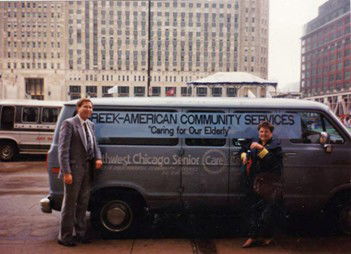
John Psiharis and Toni Panos pose with the Ya’Sou One van on Wacker Drive during staging for a Greek Independence Day parade. Date unknown. Photo by John Rassogianis. John Rassogianis collection.
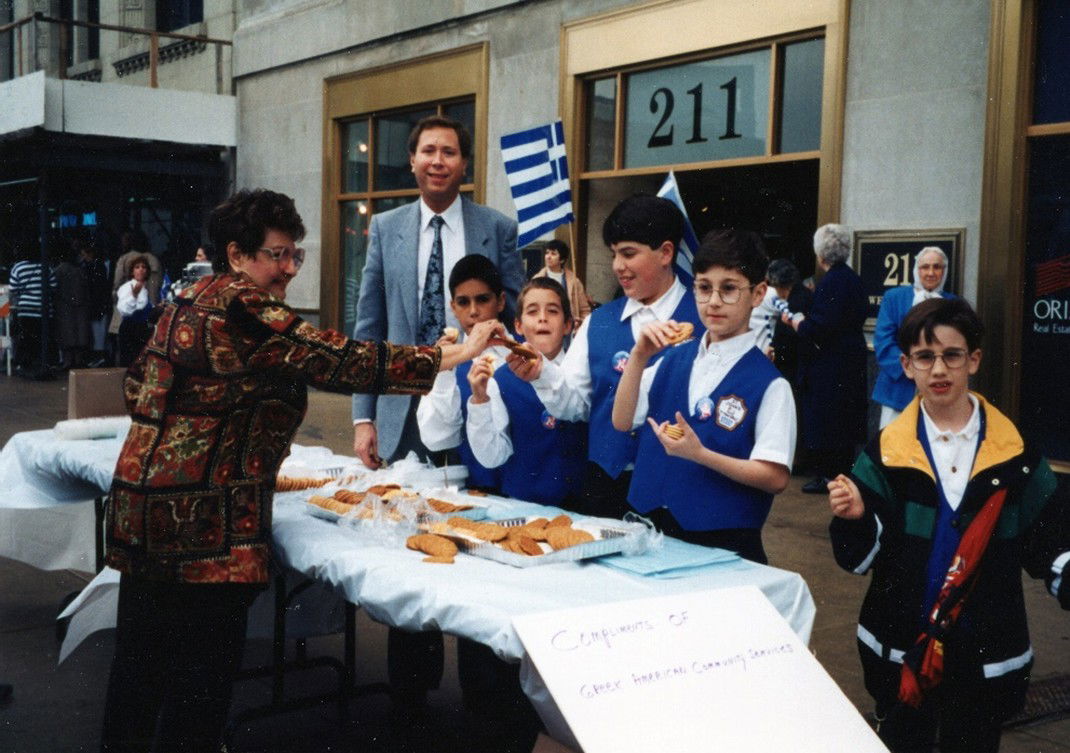
Toni Panos and John Psiharis distribute cookies and water to young parade marchers. Date unknown. Photos by John Rassogianis. John Rassogianis collection.
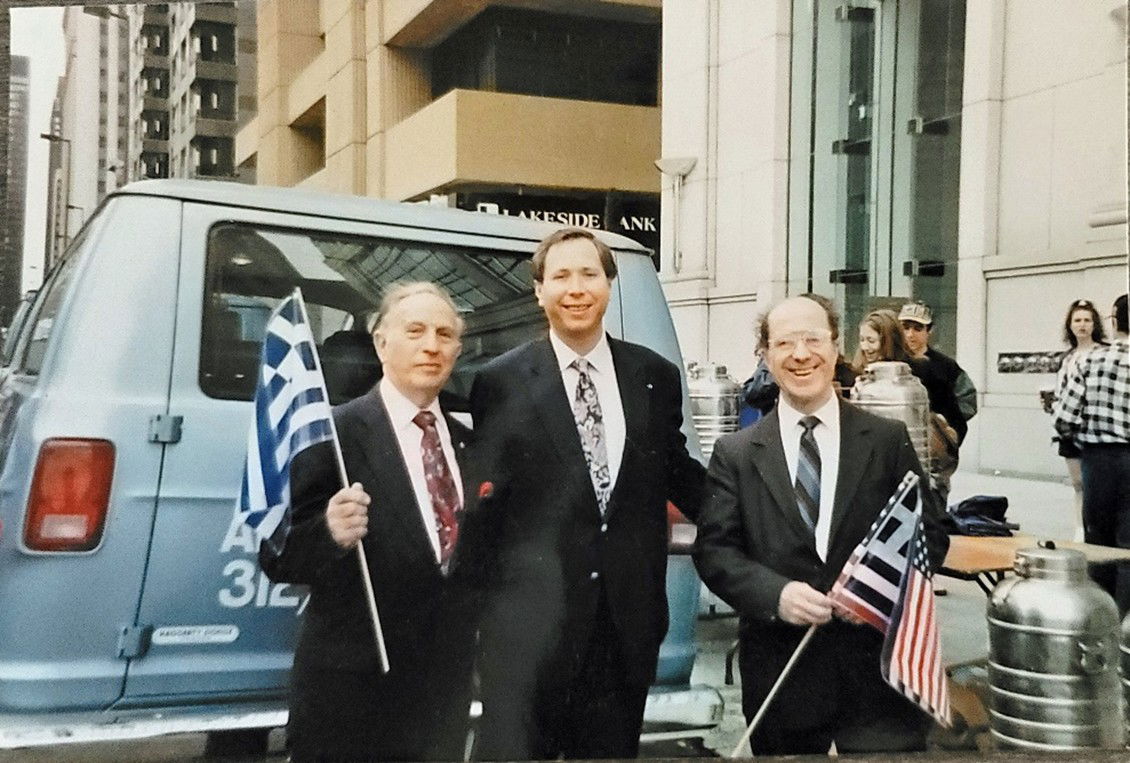
(L-R): Gus Flesor, John Psiharis, and Peter Spyropoulos at a Greek Independence Day parade. Date unknown. Photo by John Rassogianis. John Rassogianis collection.
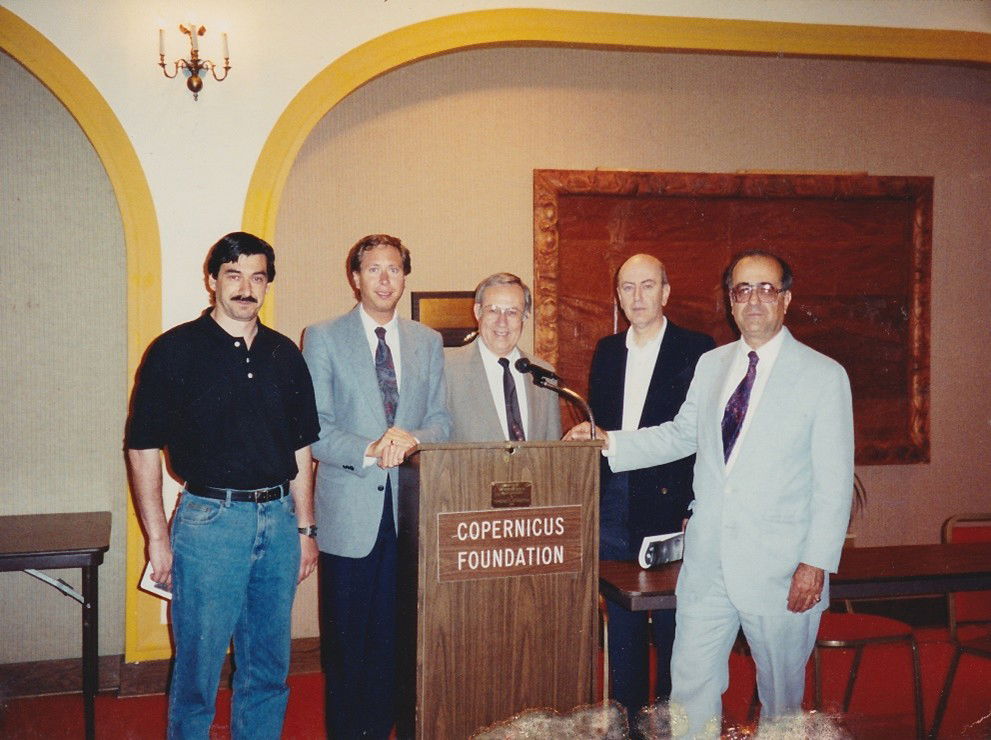
Hellenic Cultural Center committee members visit the Copernicus Foundation. Pictured (L-R): George Michalatos, John Psiharis, unknown, Nick Flevaris, and John Rassogianis. Date unknown. John Psiharis collection.
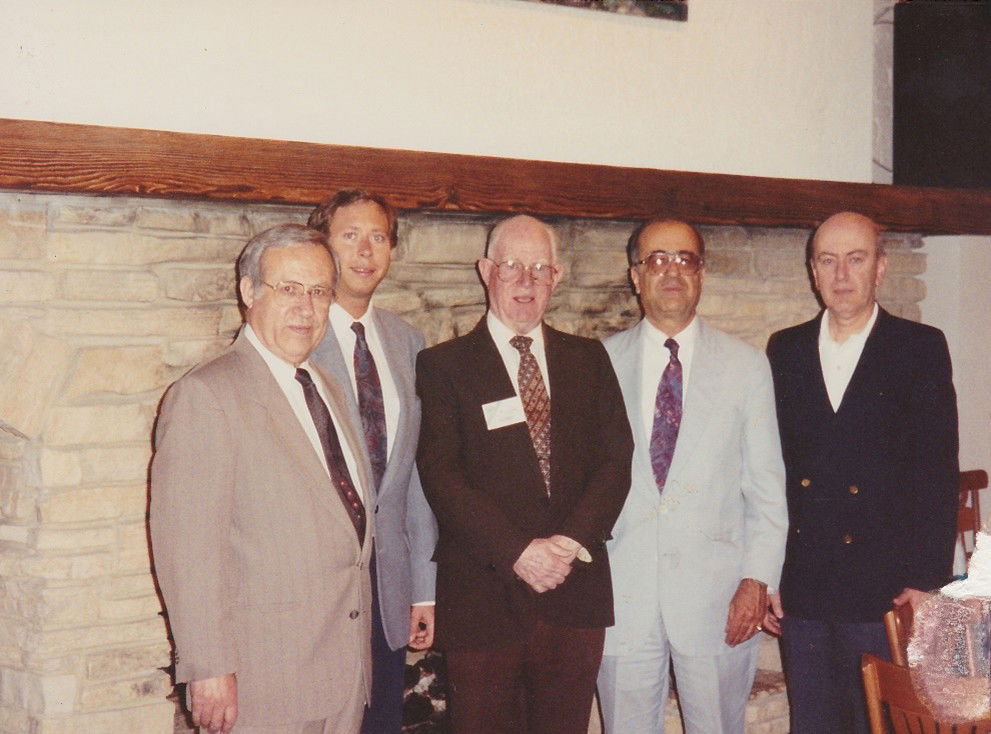
Hellenic Cultural Center committee members tour the Irish Heritage Center. Pictured (L-R): Unknown, John Psiharis, Bob Dyra, president of the Irish Heritage Center, John Rassogianis, and Nick Flevaris. Date unknown. John Psiharis collection.